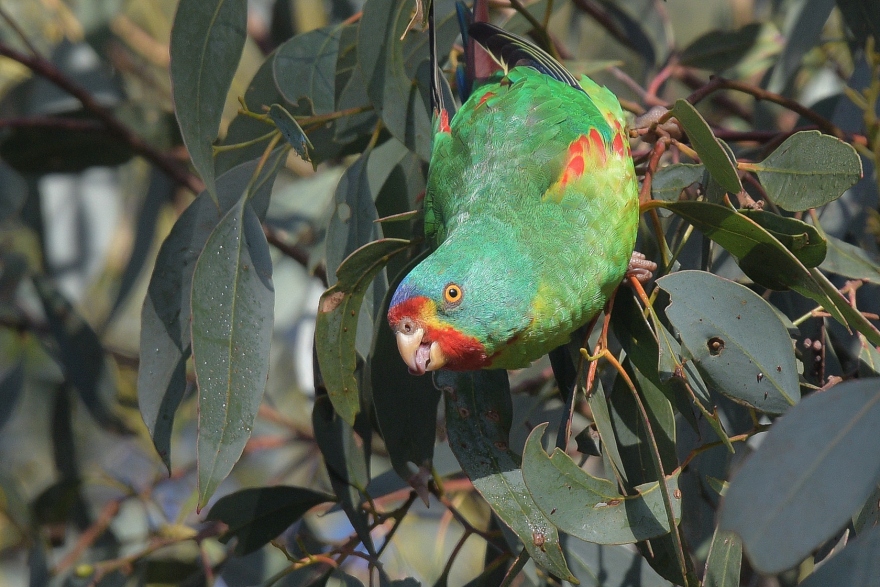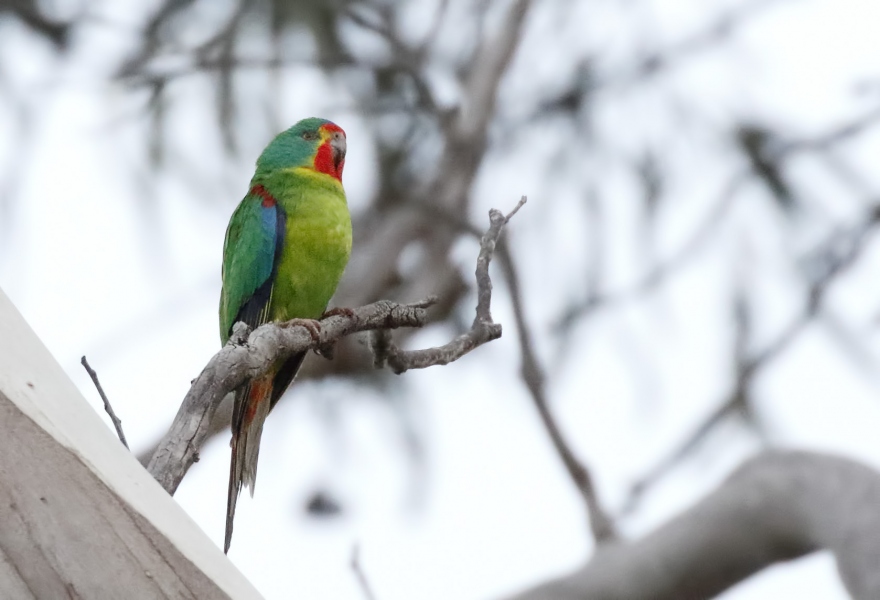The swift parrot is a medium-sized migratory parrot found in Tasmania and south-east mainland Australia. The species is critically endangered in the wild due to habitat loss and predation by sugar gliders, but the captive population is relatively stable. Ironically, the captive population of swift parrots outside of Australia greatly outnumbers the wild and domestic captive populations.

Housing & Compatibility
As their name suggests, swift parrots are capable of very fast flight. In an aviary environment, a startled bird can quite easily injure itself hitting the wire at high speed. Obstacles such as brush and foliage that interrupt direct flight paths can be incorporated in into the aviary design. Some keepers use shade cloth or some other impact-absorbing material on one end of the aviary to improve safety.
Swift parrots are a placid species that can be kept as multiple pairs per aviary if sufficient space is available. They’re reported to be safe to keep with finches and neophema parrots, but their high-speed flight does pose a collision risk.
An aviary at least three metres in length should be used to ensure swift parrots are able to get a sufficient amount of exercise. It should be positioned in a cool location, as swift parrots—like most Tasmanian species—don’t thrive in hot conditions.
Swift parrots with a high-moisture diet will produce a lot of wet faeces. An aviary that prevents birds from being able to touch their droppings is essential. This reduces exposure to dangerous bacteria and parasites. A substrate of sand or gravel that can easily be replaced or pressure-cleaned is needed in traditional style aviaries.
Diet & Feeding
Although they’re not a member of the lorikeet family, swift parrots possess a brush-tipped tongue and consume a diet that is quite similar to that of Australia’s lorikeet species. A significant portion of their wild diet comprises of pollen, nectar, and blossoms, particularly from blue gum and swamp gum trees.
In captivity, they are generally fed commercial lorikeet food (either wet or dry), fresh seasonal fruits such as apple and grapes, green seeding grasses, commercial parrot pellets, leafy greens, and small insects such as mealworms.
Swift parrots can be prone to obesity, so high fat foods like sunflower seeds should only be offered sparingly.
Many of the swift parrot’s favourite foods tend to spoil very quickly in warm weather. If their food is allowed to rot, it could expose the birds to fungal and bacterial infections. Furthermore, spoiled fruit will attract insects and other pests that could be carriers of any number of diseases. Multiple feedings throughout the day and extreme attention to hygiene is needed to successfully keep this species.

Breeding Swift Parrots
Swift parrots will breed from September through to December, as long as the weather doesn’t get too hot. They typically produce one clutch per season, though two can be achieved if conditions are optimal.
They will readily accept a wide range medium-large logs and nesting boxes. Nesting sites should be located high in the aviary to prevent vermin from gaining access. The nest box should have a shallow bed of rotting wood, sawdust or pine shavings to provide cushioning.
Although their diet is similar to that of the lorikeet species, the swift parrot’s nest box generally stays dry and tidy. Cleaning the nest while chicks are present is usually unnecessary. The nest box does still need to be thoroughly cleaned between clutches.
Swift parrots will begin breeding at between 18 months and two years of age. The hen will lay 3-5 white eggs which she then incubates alone for approximately three weeks. The young will leave the nest at six weeks of age and become independent 3-4 weeks later.
Mutations
Numerous mutations have been established overseas, including olive, cinnamon, and red-bellied. There are no known established mutations in Australian aviaries at this time, although birds with excess red plumage do show up occasionally.
A hybrid between a swift parrot and a red-rump parrot has been documented.
Sexing
Difficult (but not impossible) to visually sex. Males generally have stronger colouration than females of the same age. DNA sexing is the most accurate way to guarantee the gender of a specific bird.
Health
Due to their high-moisture diet, swift parrots are particularly prone to bacterial and fungal infections if good hygiene is not maintained. In traditional aviaries, keeping the substrate as dry as possible is essential. Ensure there is good drainage and a substrate—ideally sand—that can be frequently replaced.
Fruits, vegetables, and “wet” lorikeet food should be removed on the same day that it’s placed in the aviary. In hot weather, food will spoil more quickly so it may be necessary to provide multiple feedings throughout the day.
A preventative worming and parasite control regime should be applied to ensure the long-term health of all birds.
A properly looked after swift parrot can be expected to live for about 15 years.